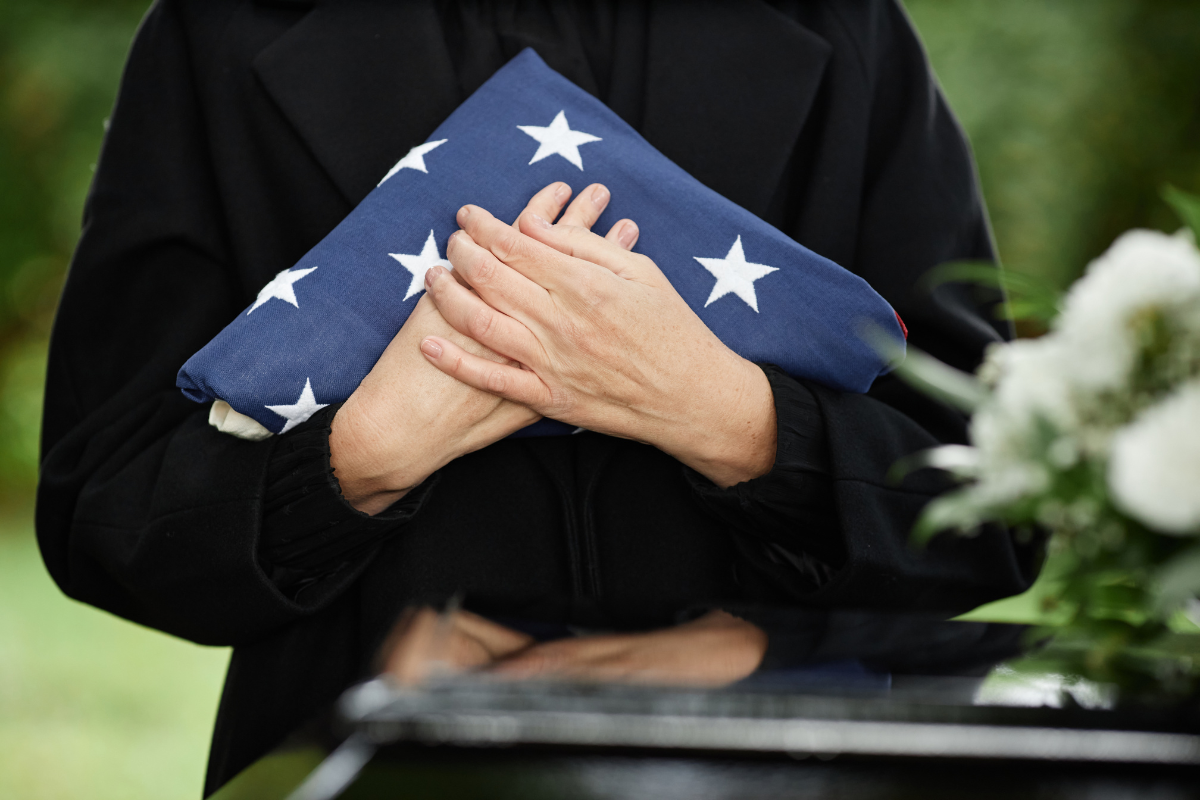Post Disclaimer: This blog reflects the author's personal experience with end-of-life matters and is provided in good faith for informational purposes only. While we aim to provide clear guidance on hard-to-find topics, this content is not legal advice and your use is at your own risk. Estate planning and end-of-life laws vary by location, so please consult your state's laws and seek guidance from a licensed attorney for your specific situation. We make no warranty about the accuracy or completeness of this information, which does not replace professional legal counsel. For more information, please see our full disclaimer.
Dealing with the loss of a loved one is never easy, and the added task of handling official matters can feel overwhelming.
When it comes to military families, knowing how to report a death to the VA is an important step in ensuring benefits and services are accurately managed.
This guide will walk you through the necessary steps to report a death to the VA, offering clarity and support for what can often be a confusing process.
Knowing how to navigate this responsibility not only supports you emotionally but also upholds the integrity of benefits like compensation and healthcare.
For a broader picture, you might also find our Death Notification Checklist helpful.

Understanding the Process of Reporting a Death to the VA
Losing a member of the family is hard enough without having to unravel the bureaucratic threads that follow.
When it comes to notifying the Veterans Administration (VA), it's essential to ensure the deceased veteran's affairs are in order.
Knowing the right steps can safeguard against unnecessary stress and pave the way for managing VA benefits efficiently.
Who Needs to Report a Death?
Imagine a ship without a captain; a situation uncharted and risky.
Reporting a death to the VA is no different. It usually falls to the next of kin, be it a spouse, child, or even an executor of the deceased's estate, to take up this responsibility.
The VA requires timely notification to adjust benefits and services, so understanding who holds this obligation is vital for preventing potential financial discrepancies.
- Next of Kin: The immediate family member, often the spouse or eldest child, plays a crucial role.
- Executor: If an executor has been appointed for the deceased's estate, they may also handle this task, bringing a formal approach to the process.
Wouldn't you opt to anchor the situation by knowing exactly whose hands steer this ship?
Importance of Reporting a Death to the VA
Think of reporting a death to the VA like turning off a running tap — it prevents overflow and wastage.
The primary aim is to ensure that benefits such as compensations, pensions, and healthcare for survivors are recalibrated accurately.
Prompt reporting allows adjustments to be made swiftly, preventing unnecessary payments and facilitating the transition to any survivor benefits or services available.
Why is this process critical?
- Prevent Overpayments: It ensures that VA benefits are stopped promptly, avoiding future recovery headaches for the estate.
- Accurate Benefits Adjustment: Assures that the family's financial plan includes any survivor benefits or pension changes swiftly.
- Peace of Mind: Knowing this task is handled frees the family to focus on grieving and moving forward, rather than mired in bureaucracy.
Ignoring this step can lead to complications akin to a mistimed dance step—just a little jarring, but certainly disruptive.
For a complete guide on a closely related process, see our article on how to report a death to the Social Security Administration.
The importance of handling these responsibilities cannot be overstated; it's a final act of care for those who stood on the front lines for our freedom.
As you navigate the waters of this difficult time, grasping the intricacies of such processes can help cut the noise and bring a much-needed sense of calm.

Steps to Report a Death to the VA
Handling the formalities after a loved one's passing is never easy.
However, reporting the death to the Veterans Administration (VA) is crucial in ensuring benefits and obligations are effectively managed.
Here's a structured approach to assist you during this challenging time.
Gather Necessary Information
Before reaching out to the VA, ensure you have all the essential documents and information. This preparation can save time and reduce stress.
- Service Number or Social Security Number of the veteran
- VA Claim Number (if applicable)
- Death Certificate: You'll need an official copy as proof of death.
- Veteran's Full Name and Date of Birth
- Marriage Certificate (if applicable): Important for spousal benefits.
- Discharge Papers (DD214 Form): This document is crucial for validating the veteran's service details.
Contacting the VA
Engaging with the VA can seem daunting, but it doesn't have to be. You can notify them through several convenient methods.
- By Phone: Call the VA’s national call center at 1-800-827-1000. This line is operational Monday through Friday.
- Online Services: Visit the VA's official website for online reporting options and further assistance.
- In Person: Head to your local VA office for face-to-face support.
Completing Required Forms
Forms are a necessary step in the reporting chain. Be sure to fill out all required documents meticulously.
- VA Form 21P-534EZ: This is used for dependency and indemnity compensation, survivors' pension, and accrued benefits. Download a copy immediately below.
- VA Form 27-0820a: Known as a Report of First Notice of Death, used for initial reporting. Download a copy immediately below.
- Submit Forms Online: Many forms can be submitted digitally via the VA's website, simplifying the process.
Follow-Up Actions
Once the immediate reporting is done, there are further actions to consider.
- Confirm Receipt: Ensure the VA acknowledges receipt of the death notice. This might mean a follow-up call or email after a week.
- Assess Benefits: Review any ongoing benefits the veteran was receiving and how they might change or cease.
- Amend Public Records: Ensure all public and personal records reflect the death accurately.
Facing the task of reporting a relative's death to the VA can feel overwhelming at first.
However, by gathering the right information, making timely contact, and ensuring all forms are correctly submitted, you can navigate through this process with confidence and calm.

What Happens After Reporting a Death?
Navigating life after a loved one passes is like entering a new chapter with unfamiliar terrain.
Reporting the death to the VA is just one step in this journey; understanding the consequences for benefits and the accompanying paperwork is critical for moving forward without stumbling blocks.
Benefits and Claims
Upon reporting a death, family members must grasp how this impacts veteran benefits.
Imagine closing the book on one story to ensure another begins smoothly. Here's how benefits and claims are affected:
- Stop Payments: The VA will cease benefits going to the deceased, a critical step to prevent overpayment and potential repayment demands.
- Transition of Benefits: Certain benefits may shift to survivors. For instance, Dependency and Indemnity Compensation (DIC) might replace the veteran's disability benefits for eligible family members.
- Pension Considerations: If the veteran was receiving a pension, explore the Survivors Pension for qualifying family members. This support aims to stabilize finances during a turbulent period.
The family's actions can smooth the transition or potentially rocky process of reframing financial stability after a loved one's passing.
Notifications and Paperwork
Reporting a death ignites a domino effect of notifications and paperwork, akin to setting several wheels in motion.
Understanding this paperwork helps dodge delays or missed opportunities in securing benefits:
- Certified Death Certificate: Obtain multiple copies—these are foundational for all subsequent steps with various agencies, including financial institutions and the VA.
- VA Notifications: After accepting the initial report, the VA may require additional documents, such as a marriage certificate or military discharge papers, to verify survivor eligibility for benefits.
- Other Agencies: Notify the Social Security Administration and update other relevant entities to prevent future confusion and ensure continued accuracy across records.
Streamlining this process ensures you're not constantly returning to collect new pieces of the puzzle, making this challenging time more manageable.
For more insight into how these responsibilities intersect with other services, consider exploring comprehensive resources like our Death Notification Checklist to maneuver other essential notifications smoothly.

Resources for Families
Navigating the aftermath of a loved one's passing is not only emotionally challenging but can also come with logistical hurdles.
For families of veterans, the task of managing and reporting their death to the Veterans Administration (VA) can be daunting.
There are various resources and support systems available to help guide families through this difficult time.
Veterans Administration Support
The VA offers several support options for families who are grieving the loss of a veteran. These resources ensure that families are not left to navigate this path alone.
- Survivor Benefits Counseling: The VA provides access to counselors who can explain the various survivor benefits available and help guide families through the application processes.
- Bereavement Counseling: Offered through the VA's Vet Centers, bereavement counseling services help family members process their loss and find healthy ways to cope. This service is available to all eligible family members.
- VA Helpline: Families can seek immediate assistance by contacting the VA Helpline at 1-800-827-1000. This line is staffed with experts who can provide guidance and answer queries regarding benefits and services.
For more information on handling the practical aspects during such times, consider visiting our guide on managing grief and fulfilling estate responsibilities.
Non-Profit Organizations
In addition to the support offered by the VA, several non-profit organizations exist to provide further assistance to veterans' families.
- Tragedy Assistance Program for Survivors (TAPS): TAPS offers peer-based emotional support, financial resources assistance, and access to grief counseling. Their networks connect families with ongoing support to support their healing journey.
- American Red Cross: Known for its emergency response, the American Red Cross also offers resources for military families experiencing loss, including emotional resilience workshops and support networks.
- Gold Star Families: This organization offers support and advocacy for families of fallen service members. They offer various programs and resources aimed at providing comfort and community.
These organizations work tirelessly to ensure that no family member feels isolated in their grief.
They offer critical resources that foster a network of understanding and solidarity.
Incorporating both VA resources and non-profit support can provide a well-rounded base of assistance during these trying times.
For further guidance and checklists that can help streamline the process of dealing with a family death, please explore our death notification checklist.

Key Takeaways When Reporting a Death to the VA
As you journey through the complex task of reporting a death to the VA, remember that you're not alone.
This step is vital in managing transitions and preserving the benefits due to the family.
Taking swift and informed actions can make a significant difference during this challenging period.
Essential Points to Remember
- Prioritize Information Gathering: Having correct documents ready accelerates the process. This includes the veteran's service number and official death certificate.
- Multiple Reporting Methods: Choose a reporting method that suits you best, whether it’s via phone, online, or in person. Remember, informed contacts at the VA can walk you through these processes.
- Understand Benefit Transitions: Reporting a death to the VA changes existing benefits but also opens up potential survivor benefits. Being proactive in acknowledging these changes can stabilize the family’s financial future.
- Utilize Available Resources: Both the VA and non-profit organizations offer invaluable support for families. Engagement can ease the burden and provide much-needed guidance.
Taking action is key. If you find yourself in this scenario, reach out to the VA immediately.
Timeliness can prevent unnecessary complications and pave the way for your family to receive any continued benefits or support they deserve.
For more comprehensive support, explore additional guides on managing these processes on the Up & Doing platform to ensure you're fully equipped for every step of this journey.
Check out the Up & Doing glossary page for an alphabetical listing of key terms related to estate administration, funeral planning, and other end-of-life topics.




